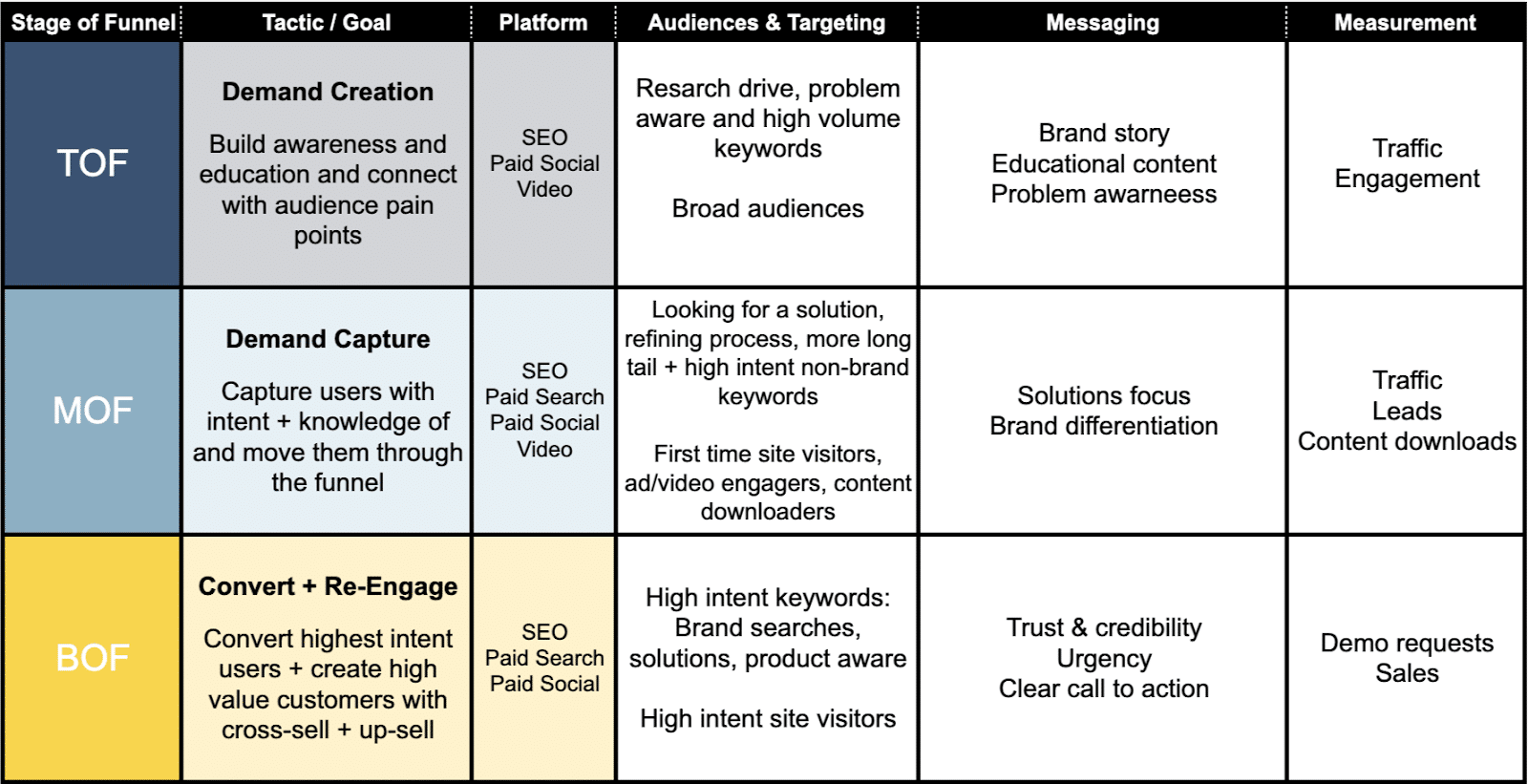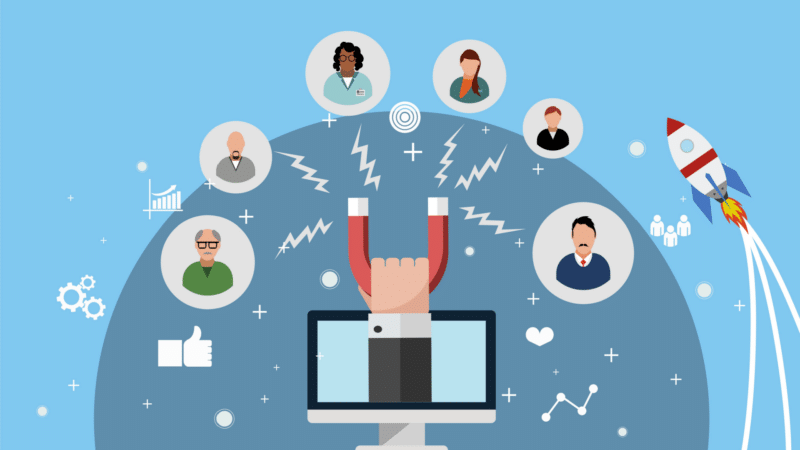A better approach to B2B lead gen in 2024
Improve your B2B lead gen ROI by matching offers, ad channels and educational content to the user's awareness and intent level.


B2B advertising, with its long sales cycles and relatively thin data density, has never been easy. And the tracking upheaval from cookies disappearing is about to make it harder.
That means that some of the pervasive flaws I’ve seen in inheriting B2B lead gen accounts over the years are about to produce even shakier results.
Even without talking about cookies and alternative measurement set-ups, there’s a better path forward for lead gen in 2024. This article will examine:
- What brands still get wrong about their lead gen fundamentals.
- How to align the offer and the funnel stage.
- How to align the channel mix and the funnel stage.
- How to qualify users with content.
What brands are getting wrong about lead gen
The single biggest mistake I see brands making with lead gen is misjudging (or ignoring) the intent of the lead.
A common example here is asking a cold prospect to request a demo, which is a leap of faith that will very rarely be rewarded with positive ROI or pestering prospects that download content to engage with sales.
The second big mistake is that brands will stop measuring beyond the lead, which leads to misappropriating budget and clear blind spots in performance.
Movement between funnel stages, lead quality and lead progression to MQLs > SQLs > opportunities > closed deals are all vital for lead gen marketers to understand. This lets you assess your campaigns’ performance and optimization priorities – and spend your budget where it will have the biggest impact on the bottom line.
Dig deeper: Top 5 paid search B2B lead gen strategies for 2024
How to align your offer with the user’s funnel stage
I use this chart all the time with my clients (and sometimes in my articles for Search Engine Land):
The top of the funnel is about educating and relating to the user:
- What they need to learn.
- What challenges they need to solve.
- What they need to know about their problem.
At this point, it’s about relating to their pain points and starting to build trust more than what they need to solve than they do about who’s solving it for them.
The middle of the funnel starts tying solutions to problems and introduces your brand as the option:
- Why your solution works.
- How it’s different from your competitors.
- The results you’ve driven for brands with similar challenges.
This stage assumes the user has their head around their challenge and is now actively researching solutions to help.
The bottom of the funnel brings in more emotion and third-party proof. This stage assumes the users have a shortlist of solutions in mind and are looking for reassurance, from case studies and testimonials, that yours is the one for them. This is also when you can start leaning on urgency, with limited sales windows or expiring promotions.
The most important thing to remember from all of this is that thoughtful nurturing is key to good lead gen. If you’re using bottom-funnel tactics for people who haven’t heard of you yet, you’re only wasting time and possibly turning users off from your brand.
How to align the channel mix and the funnel stage
Top-of-funnel channels
Starting with awareness/top-of-funnel targeting should mean starting on LinkedIn (and, for some brands with access to the right audiences, possibly on Facebook).
My first option is always to start with LinkedIn prospecting because:
- Costs are cheaper for top-of-funnel engagement than they are for lead generation or conversion.
- LinkedIn’s company-based targeting means you can go fairly broad and still stay within your ICP.
LinkedIn is a great place for educating users and positioning your brand as a thought leader; people go to LinkedIn to consume content, perhaps in the form of thought leader ads, and are open to high-quality, informative engagements.
I approach Facebook prospecting with caution, but it can be worth testing depending on the audience.
Middle-of-funnel and retargeting channels
Once someone has engaged with your brand and content, you should have started to narrow your audience.
Whether you’re retargeting content engagers or focused on accounts that have engaged with sales in some way or piped-in audiences from tools like Clearbit or 6Sense, I recommend choosing the following combinations of ad types and channels:
- LinkedIn sponsored content and conversation ads.
- Facebook and Instagram in-feed ads or video ads, with messaging that aligns with your audience and funnel stage.
Given my thoughts on Facebook prospecting, you might be surprised at my preference here. But you’ve already defined the audience.
Facebook/Instagram can help expand your audience matching scope beyond LinkedIn (where we’ve seen plenty of audience match degradation), and retargeting costs tend to be lower.
Bottom-of-funnel channels
Focusing on users who have engaged with high-intent content or visited your site multiple times is a crucial audience for this stage.
Ensuring coverage for paid search and high-intent SEO queries are the bread and butter for capturing intent at this stage, but paid social is a great way to generate that last step of intent by using social proof like case studies, testimonials, etc. – and sealing the deal with demo offers.
These will be your highest engagement costs of the campaign, and they should be, since leads at this stage are (assuming you’ve qualified them along the way) extremely valuable.
Dig deeper: How to implement a full-funnel PPC marketing strategy
How to qualify users with content
This happens throughout the funnel, and lots of this work is done with the type of content you’re offering.
For instance, your content should help the platforms’ bidding and targeting algorithms identify the audience’s pain points, solutions, etc. (Facebook’s algorithm can do this, but it doesn’t have the all-important layer of company targeting that LinkedIn does.)
There can also be ways to increase engagement within your ICP by speaking directly to them in your copy. Identifying opportunities to call out your audience in messaging is a great tactic.
For example, if you’re targeting CFOs, try “CFOs’ Favorite Answer to {Challenge} in 2024” or something similar that lets them know your content is for them.
The bonus here is that the more tightly you align your messaging with your ICP, the more you can delineate who falls outside your ICP and shouldn’t bother engaging with your ad.
Dig deeper: Paid search for lead gen: Tips for new accounts with limited budgets
Aligning tactics to intent: A better B2B lead gen approach
Above all, remember to consider the user’s mentality when developing your lead gen campaigns.
Don’t:
- Ask for too much too early.
- Get silly with retargeting frequency.
- Bother spending for bottom-funnel engagement without so much as a how-do-you-do.
Cookies or not, adhering to those principles will help you eliminate a lot of waste from your lead gen campaigns and keep your brand from developing a pushy reputation.























